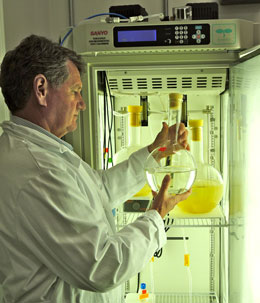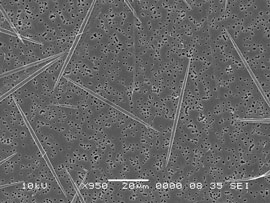Nitrogen from pollution, natural sources causes growth of toxic algae
SAN FRANCISCO, Feb. 6, 2013 -- Nitrogen in ocean waters fuels the growth of two tiny but toxic phytoplankton species that are harmful to marine life and human health, warns a new study published in the Journal of Phycology.
Researchers from San Francisco State University found that nitrogen entering the ocean -- whether through natural processes or pollution -- boosts the growth and toxicity of a group of phytoplankton that can cause the human illness Amnesic Shellfish Poisoning.

William Cochlan checks a culture of phytoplankton diatoms (cells), taken out of a cell incubator at SF State's Romberg Tiburon Center for Environmental Studies. Credit: Chris Ikeda/SF State
Commonly found in marine waters off the North American West Coast, these diatoms (phytoplankton cells) of the Pseudo-nitzschia genus produce a potent toxin called domoic acid. When these phytoplankton grow rapidly into massive blooms, high concentrations of domoic acid put human health at risk if it accumulates in shellfish. It can also cause death and illness among marine mammals and seabirds that eat small fish that feed on plankton.
"Regardless of its source, nitrogen has a powerful impact on the growth of phytoplankton that are the foundation of the marine food web, irrespective of whether they are toxic or not," said William Cochlan, senior research scientist at SF State's Romberg Tiburon Center for Environmental Studies. "Scientists and regulators need to be aware of the implications of both natural and pollutant sources of nitrogen entering the sea."
Nitrogen can occur naturally in marine waters due to coastal upwelling, which draws cool, nutrient-rich water containing nitrate (the most stable form of nitrogen) from deeper depths into sunlit surface waters. Pollution, including agricultural runoff containing fertilizer and effluent from sewage plants, is also responsible for adding nitrogen, including ammonium and urea, to ocean waters, but in most regions these types of nitrogen occur at relatively low concentrations.

A scanning electron micrograph image of the phytoplankton species Pseudo-nitzschia cuspidata (the long, thin needle-like objects). Credit: Brian Bill/NOAA.
In laboratory studies, Cochlan and former graduate student Maureen Auro found that natural and pollution-caused nitrogen forms equally support the growth of the harmful Pseudo-nitzschia algae and cause the production of the domoic acid, but in all cases the natural form of nitrogen caused the most toxic cells.
They also found that these small diatoms became particularly toxic under low light levels – a condition that usually slows the growth of phytoplankton. The species, P. cuspidata, underwent an up to 50 fold increase in toxicity under low light levels compared to the conditions that are thought to normally favor phytoplankton growth.
Scientists already know that in some large-celled species of Pseudo-nitzschia their toxicity increases when the cells grow slower, but in previous studies the slowing of cellular growth was due to the limitation of vital nutrients, such as silicate. However Cochlan's latest study found that the toxicity of these small toxigenic diatoms is affected by the type of nitrogen they consume. He found that under low light levels -- leading to slow growth -- phytoplankton cells that were fed on naturally occurring nitrate were more toxic than cells that were fed on either urea or ammonium caused by pollution.
"Our results demonstrate that the reason for the growth of these specific harmful algal blooms off the coast of North America from British Columbia to California may in fact be due to totally natural causes," Cochlan said.
Such toxic algal blooms may be largely supported by the natural upwelling of nitrogen. However, Cochlan cautions that when the pattern of upwelling is weaker, nitrogen from pollution could play an important role in sustaining a "seed population" of harmful algae – a remnant that keeps the bloom going until upwelling resumes and the bloom is able to grow again and perhaps increase their toxic effect on the marine ecosystem.
"This is the first physiological study to look at the environmental conditions that promote both the growth and the toxicity of these small diatoms," Cochlan said. "The findings may shed light on why these microorganisms produce a potent neurotoxin and what the ecological advantage is for the phytoplankton producing it."
"Nitrogen Utilization and Toxin Production by Two Diatoms of the Pseudo-nitzschia pseudodelicatissima complex: P. cuspidata and P. fryxelliana," was published in the February 2013 issue of the Journal of Phycology. The paper was authored by Maureen E. Auro, a graduate of the marine biology master's program at SF State, and William P. Cochlan, senior research scientist at SF State's Romberg Tiburon Center for Environmental Studies.
The study was funded by the National Science Foundation's Ecology and Oceanography of Harmful Algal Blooms program (ECOHAB).